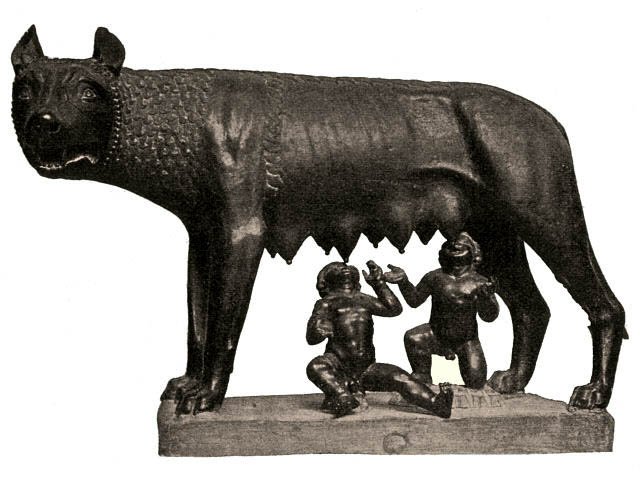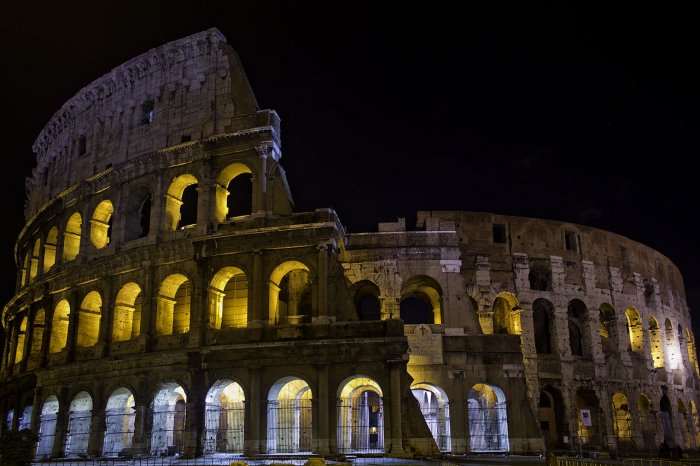Why Is Rome Called ‘The Eternal City’?
Conny Waters - AncientPages.com - Have you ever wondered why Rome became known as the "Eternal City? The city's nickname can be traced to an ancient myth, ancient historical writings, and the old Romans' beliefs in the greatness of their city.
The Capitoline she-wolf with the boys Romulus and Remus. Museo Nuovo in the Palazzo dei Conservatori, Rome. Rome is much older than the myth about Romulus and Remus. Benutzer:Wolpertinger - Public Domain
According to an ancient legend, the city of Rome was founded on April 21, 753 B.C. by Romulus.
Romulus and Remus were twin brothers and sons of the god Mars. Thrown into the river Tiber by a wicked uncle hoping they would drown, the small boys were rescued by a wolf who fed them.
When Romulus and Remus became adults, they decided to establish their city, and each set out to find the best location. They were later discovered and cared for by a shepherd and his wife: Faustulus and Acca Larentia. One day, the two brothers quarreled over where the site should be, and his brother killed Remus.
It left Romulus the sole founder of the new city, and he gave his name to it – Rome. Now, this is just a myth, and the history of Rome goes much further back in time.
According to the legend, Romulus became the first king of Rome in 753 BC. Legends say Numa Pompilius was the second king of Rome, but he was not a warrior king but a statesman and politician.
Nevertheless, archaeologists have discovered artifacts that prove Rome was inhabited much earlier than 753 B.C.
Rome was known as the "Eternal City" because civilizations had lived there for thousands of years. The ancient Roman Empire was mighty, and it had many enemies. Yet, ancient Romans managed to defeat the Carthaginians and Etruscans and extended their empire throughout Europe and Africa. No one underestimated the greatness of the ancient Roman Empire.
Between c. 100 B.C to around 400 A.D, the city of Rome was the largest in the world.
Around 500 A.D., Empire's populace grew to an estimated 50 to 90 million. At the time, this was roughly 20% of the world's population.
Roman writers and poets boasted about their city's greatness. In his epic poem The Aeneid, the poet Virgil wrote the line imperium sine fine – an empire without end.
The first explicit reference to Rome as the Eternal City occurred in the 1st century B.C. Poet Albius Tibullus (55 BC - 19 BC) wrote ‘Romulus aeternae nondum formaverat urbis moenia, consorti non habitanda Remo’ – Tibullus, from Elegies.
In other words, 'not yet had Romulus drawn up the Eternal City's walls, where Remus as co-ruler was fated not to live.
Ancient writers such as Ovid and Livy also took up the expression.
It's no wonder that ancient Romans thought that whatever happened to the rest of the world, Rome would last forever. Rome became known as the "Eternal City."
Rome is called the "Caput Mundi" (Capital of the World). The ancient Roman Empire is long gone, but we still call Rome the "Eternal City."
Romulus and Remus were twin brothers and sons of the god Mars. Thrown into the river Tiber by a wicked uncle hoping that they would drown, the small boys were rescued by a wolf who fed them.
They were later discovered and cared for by a shepherd and his wife: Faustulus and Acca Larentia. When Romulus and Remus became adults, they decided to establish their own city, and each set out to find the best location. One day, the two brothers quarreled over where the site should be, and his brother killed Remus.
This left Romulus the sole founder of the new city, and he gave his name to it – Rome. Now, this is just a myth, and the history of Rome goes much further back in time.
According to the legend, Romulus became the first king of Rome in 753 BC. Legends say Numa Pompilius was the second king of Rome, but he was not a warrior king but rather a statesman and politician.
Nevertheless, archaeologists have discovered artifacts that offer evidence Rome was inhabited much earlier than 753 B.C.
Rome was known as the “Eternal City” because civilizations had lived there for thousands of years. The ancient Roman Empire was very powerful, and it had many enemies. Yet, ancient Romans managed to defeat the Carthaginians and Etruscans and extended their empire throughout Europe and Africa. No one underestimated the greatness of the ancient Roman Empire.
Between c. 100 B.C to around 400 A.D, the city of Rome was the largest city in the world. Around 500 A.D., Empire's populace grew to an estimated 50 to 90 million inhabitants. At the time, this was roughly 20% of the world's population.
Colosseum at night. Image credit: Ramesh - CC BY-SA 3.0
Roman writers and poets boasted about their city’s greatness. In his epic poem The Aeneid, the poet Virgil wrote the line imperium sine fine – an empire without end.
The first explicit reference to Rome as the Eternal City occurred in the 1st century B.C. Poet Albius Tibullus (55 BC - 19 BC) wrote ‘Romulus aeternae nondum formaverat urbis moenia, consorti non habitanda Remo’ – Tibullus, from Elegies.
In other words, ‘not yet had Romulus drawn up the Eternal City’s walls, where Remus as co-ruler was fated not to live’.
The expression was also taken up by ancient writers such as Ovid and Livy.
It’s no wonder that ancient Romans thought that whatever happened to the rest of the world, Rome would last forever. Rome became known as the “Eternal City”.
Rome is also called the "Caput Mundi" (Capital of the World). The ancient Roman Empire is long gone, but we still call Rome the “Eternal City.”
Updated on May 2, 2023
Written by Conny Waters – AncientPages.com Staff Writer
Copyright © AncientPages.com All rights reserved. This material may not be published, broadcast, rewritten or redistributed in whole or part without the express written permission of AncientPages.com
More From Ancient Pages
-
 Ancient Pottery Found On The European Atlantic Coast Sheds Light On Cooking In The Bronze Age
Archaeology | Jan 16, 2024
Ancient Pottery Found On The European Atlantic Coast Sheds Light On Cooking In The Bronze Age
Archaeology | Jan 16, 2024 -
 Strange Case Of The ‘Impossible’ Glove Remains Unexplained – The Discovery – Part 1
Featured Stories | May 24, 2019
Strange Case Of The ‘Impossible’ Glove Remains Unexplained – The Discovery – Part 1
Featured Stories | May 24, 2019 -
 Anomalous Ancient Structures In The South West Pacific Remain Unexplained
Civilizations | May 19, 2018
Anomalous Ancient Structures In The South West Pacific Remain Unexplained
Civilizations | May 19, 2018 -
 Amazing World’s Largest Mosaic Piece Made By 13 Different Ancient Civilizations At Museum Hotel Antakya
Featured Stories | May 9, 2019
Amazing World’s Largest Mosaic Piece Made By 13 Different Ancient Civilizations At Museum Hotel Antakya
Featured Stories | May 9, 2019 -
 Ancient Tomb Of Exceptional Priest Kaires – The Sole Friend And Keeper Of The Secret Of The Morning House Discovered In Egypt
Archaeology | Oct 9, 2018
Ancient Tomb Of Exceptional Priest Kaires – The Sole Friend And Keeper Of The Secret Of The Morning House Discovered In Egypt
Archaeology | Oct 9, 2018 -
 Ivar The Boneless: Famous Viking And Son Of Ragnar Lodbrok
Featured Stories | Jun 6, 2016
Ivar The Boneless: Famous Viking And Son Of Ragnar Lodbrok
Featured Stories | Jun 6, 2016 -
 Incredible Ancient Extinct World Of Unknown Organisms Discovered
Evolution | Jun 8, 2023
Incredible Ancient Extinct World Of Unknown Organisms Discovered
Evolution | Jun 8, 2023 -
 Did Crassus, Ancient Rome’s Wealthiest Man Really Die From Drinking Molten Gold?
Featured Stories | Feb 15, 2017
Did Crassus, Ancient Rome’s Wealthiest Man Really Die From Drinking Molten Gold?
Featured Stories | Feb 15, 2017 -
 Pryor Mountains Are Home To The Mysterious Little People – Native Americans Say
Featured Stories | Aug 2, 2021
Pryor Mountains Are Home To The Mysterious Little People – Native Americans Say
Featured Stories | Aug 2, 2021 -
 Cave Hidden Under Pembroke Castle in Wales Could Hold Secrets Dating Back 10,000 Years
Archaeology | Jul 16, 2022
Cave Hidden Under Pembroke Castle in Wales Could Hold Secrets Dating Back 10,000 Years
Archaeology | Jul 16, 2022 -
 Mystery Of Viking Ship Burials In Hjarnø, Denmark And Their Unusual Design
Archaeology | Jun 1, 2021
Mystery Of Viking Ship Burials In Hjarnø, Denmark And Their Unusual Design
Archaeology | Jun 1, 2021 -
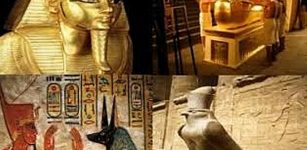 10 Fascinating Facts About Pharaohs
Ancient History Facts | Jun 21, 2016
10 Fascinating Facts About Pharaohs
Ancient History Facts | Jun 21, 2016 -
 Unexpected Underwater Discovery Of 50,000 Ancient Coins Off Sardinia Hints At Hidden Shipwreck
Archaeology | Nov 10, 2023
Unexpected Underwater Discovery Of 50,000 Ancient Coins Off Sardinia Hints At Hidden Shipwreck
Archaeology | Nov 10, 2023 -
 Early Farmers On The Baltic Coast Incorporated Fish Into Their Diets 6,000 Years Ago
Archaeology | Oct 17, 2023
Early Farmers On The Baltic Coast Incorporated Fish Into Their Diets 6,000 Years Ago
Archaeology | Oct 17, 2023 -
 Horses Skinfaxi And Hrimfaxi – Bringers Of Light And Darkness To Earth In Norse Mythology
Featured Stories | Dec 16, 2017
Horses Skinfaxi And Hrimfaxi – Bringers Of Light And Darkness To Earth In Norse Mythology
Featured Stories | Dec 16, 2017 -
 Discovery Of Stone Age Textiles Sheds New Light On The History Of Clothes Making
Archaeology | Nov 9, 2021
Discovery Of Stone Age Textiles Sheds New Light On The History Of Clothes Making
Archaeology | Nov 9, 2021 -
 1,000 Bog Bodies From Across Scandinavia Reveal More Ancient Secrets – Here’s What Scientists Found
Archaeology | Mar 20, 2023
1,000 Bog Bodies From Across Scandinavia Reveal More Ancient Secrets – Here’s What Scientists Found
Archaeology | Mar 20, 2023 -
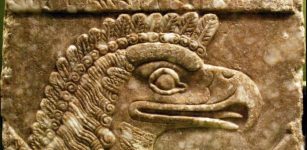 Adapa – Why Did The Wise Apkallu Refuse The Gift Of Immortality?
Featured Stories | May 9, 2019
Adapa – Why Did The Wise Apkallu Refuse The Gift Of Immortality?
Featured Stories | May 9, 2019 -
 Dangerous Anomaly Inside Mysterious European Mountain Remains Unexplained – Unusual Ancient Connections – Part 1
Featured Stories | Mar 13, 2021
Dangerous Anomaly Inside Mysterious European Mountain Remains Unexplained – Unusual Ancient Connections – Part 1
Featured Stories | Mar 13, 2021 -
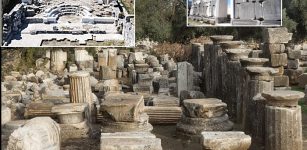 Restorations At Stratonicea Ancient City Of Gladiators In Turkish Muğla Province
Archaeology | May 10, 2023
Restorations At Stratonicea Ancient City Of Gladiators In Turkish Muğla Province
Archaeology | May 10, 2023

